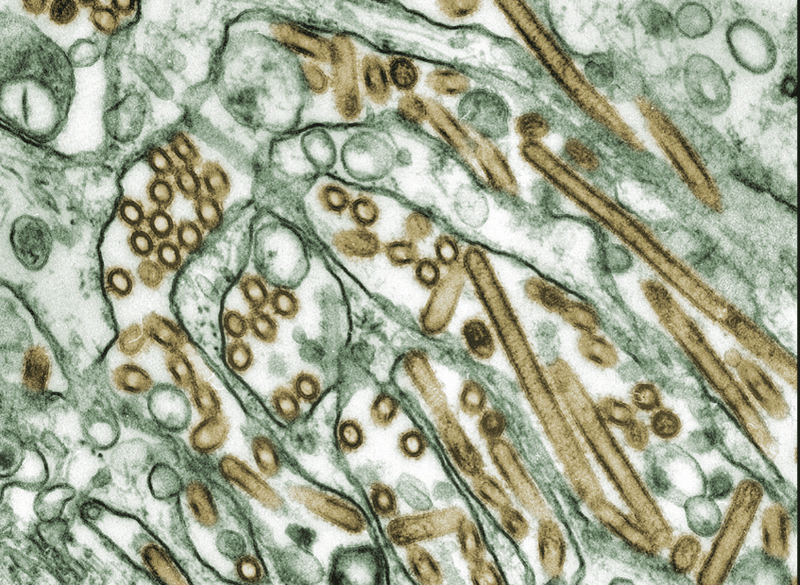by Dr. Sarah Treanor Bois, PhD
Director of Research & Education at the Linda Loring Nature Foundation
The latest avian flu has been detected on Nantucket and is now spreading to multiple species of wild birds. A local task force is keeping tabs on the situation and new local research is hoping to shed light on the situation.
Since December 2021, an outbreak of Eurasian strain Highly Pathogenic Avian Influenza (HPAI) H5N1 virus has fatally affected many bird species in North America, especially farm-raised birds and wild waterfowl. A similar HPAI strain was previously identified in Europe and Asia beginning in 2019, which resulted in rapid spread and massive mortality among these types of species. According to the Center for Disease Control and Prevention, unlike the virus in Europe, the HPAI virus detected in North America has not only affected domestic poultry farms, but has been confirmed in many migrating shorebirds and waterfowl, as well as in birds of prey that likely consumed HPAI-infected birds. But the list of affected bird species is still evolving as more research and testing is being administered. HPAI, however, does not affect all types of birds equally. The “highly pathogenic” part of the term HPAI refers specifically to the severity of the disease in poultry, not necessarily in other bird species.
The last case of HPAI in North American wild birds occurred in 2015. That outbreak resulted in the deaths of more than 50 million domestic birds in 15 states and accounted for 98 detections in infected wild birds—a number that pales in comparison to this year’s confirmed cases.
This type of avian flu is considered a low risk to people, according to the U.S. CDC. However, it could be trouble for both domestic and wild bird populations. The virus, which can cause severe neurological and respiratory issues in avians, was likely transmitted to North America through migratory bird routes that overlap with regions of Europe.
In Massachusetts, HPAI was first detected in February when two Canada geese tested positive. Typically, a threat to mainly domestic poultry, the virus has since infected and killed an unprecedented number of wild birds, worrying experts. HPAI has now been detected in both domestic and wild birds from Canada to Florida for the past several months. If you’re interested in how the disease has spread, the HPAI distribution map is being updated weekly or as frequently as documented changes in distribution are available.
Nantucket had been keeping a close watch on cases and where they were located. This winter, a mute swan from Nantucket tested positive—the first confirmed case on-island. Since then, multiple species here have been found to be positive for HPAI. To keep track of the virus on Nantucket, a HPAI Task Force was created in February: members include regulatory agencies, town officials, conservation and research groups, as well as animal welfare organizations. The purpose of the group is to track and respond as necessary to the infection on-island.
Initially, the primary species affected were waterfowl, domestic fowl, and some shorebirds. The list of affected species keeps growing as the spread of infection evolves. Corvids and blackbirds are now infected.
At the end of June, hundreds of dead birds washed up on the beaches of Martha’s Vineyard and some on Nantucket. This story made national news, but the birds were originally identified as cormorants were actually shearwaters. Some of the birds were collected and sent to Tufts for testing. Tests have not yet confirmed HPAI, but MV town official released warning to that island and are presuming it is part of the outbreak. Others think it was possibly food shortage that caused the mass die-off.
On Nantucket, primarily only dead birds had been tested for the virus. We’ve had American crows, a mute swan, greater black-backed gulls, and other waterfowl all test positive. At the Linda Loring Nature Foundation, we sent off an adult osprey that was found dead on the property in April. This osprey was also banded, so we had a bit more info. The osprey was positive for HPAI. It had been banded by Dr. Bob Kennedy in 2008 as a chick.
For infected birds of prey like red-tailed hawks, great horned owls, cooper’s hawks, and peregrine falcons, it is believed they became infected by their prey – most likely other avian species who had HPAI. The osprey was unusual in that osprey eat fish almost exclusively. Leading to more questions about transmission.
This particular strain of HPAI appears to be more infectious and deadly to wild birds than previous versions, but gauging the pathogen’s true impact on wild populations is more difficult than with domestic poultry which are observed and documented every day. Much of the testing is being done one dead bird at a time without knowing how many others are carriers of the disease.
In order to help assess the extent of infection on Nantucket, the Linda Loring Nature Foundation (LLNF) is undertaking a new study looking at passerine and other songbirds. As outbreaks of HPAI have been blamed for large scale mortality events among wild birds, LLNF hopes to identify any potential warning signs of detrimental outbreaks among these species by surveilling the resident and migratory songbirds of Nantucket focusing on feeder birds.
The virus is challenging to detect with certainty. Some birds may exhibit observable signs such as neurologic abnormalities, nasal discharge, coughing, sneezing, swelling, or discoloration of un-feathered body parts, but many that have contracted the virus are completely asymptomatic. This is why most detections are from already-dead birds that were sampled.
An efficient way to investigate the presence of an HPAI infection is by collecting fecal samples to be tested in a lab. Studies have shown the HPAI virus is shed abundantly in bird feces. Sampling the fresh bird feces will allow us, at LLNF, to investigate HPAI prevalence in feeder birds – helping answer an important conservation question. We’ll also be sampling material from a bird bath to help answer questions about what to do with your feeders and bird baths. Are they vectors for disease? We’ve teamed up with Dr. Wendy Puryear of Cummings School of Veterinary Medicine at Tufts University and Dr. Nichola Hill of UMASS Boston who will be processing the samples and advising on collection methods. Both researchers have already been working locally with the UMASS Boston Field Station and Offshore Animal Hospital on the detection of HPAI in dead birds. Preliminary data from USDA Animal and Plant Health Inspection Service (APHIS) reports detections of HPAI in multiple songbird species, including several Corvid species, a common grackle, and an American robin, as well as a potential outbreak event among swallows. This study will be a first step in seeing if HPAI is detectable in our Nantucket songbirds.
The Department of Fish and Game’s (DFG) Division of Fisheries and Wildlife (MassWildlife), the Massachusetts Department of Agricultural Resources (MDAR), and the Massachusetts Department of Public Health (DPH) are advising the public to refrain from touching or removing birds from coastal areas that appear sick, injured, or deceased.
If you see a bird in distress or a dead bird, don’t touch it and keep dogs away from carcasses. It has been determined the virus can stay within the carcasses for 3-5 days. MassWildlife State Ornithologist Andrew Vitz states, “We are asking for the public’s help in reporting observations of sick shorebirds along the coastline. Prompt reporting will expedite testing and diagnosis in cooperation with our state and federal partners who have been monitoring HPAI for several years.”
Locally, if you have a dead or visibly sick bird, call Offshore Animal Hospital which will direct the call to the proper responders. You can also call our Environmental Officer who is part of the Nantucket HPAI task force. MassWildlife also has a new site for reporting dead WILD birds at mass.gov/forms/report-observations- of-dead-wild-birds. They are particularly interested in sick and dead seabirds washing up along coastal areas.
If you have poultry, even a backyard farm, these birds are potentially at risk, since we know how quickly the virus spreads among flocks. Prevention is the best protection against the HPAI virus. Keep wild waterbirds away from your flock. Visit the MDAR’s Poultry Page for updates and biosecurity resources available in multiple languages: mass.gov/service-details/poultry-program.
For the most up-to-date information, follow social media of the Linda Loring Nature Foundation, the UMASS Boston Nantucket Field Station, and other conservation groups as we all work together to help spread more information about HPAI on Nantucket.



